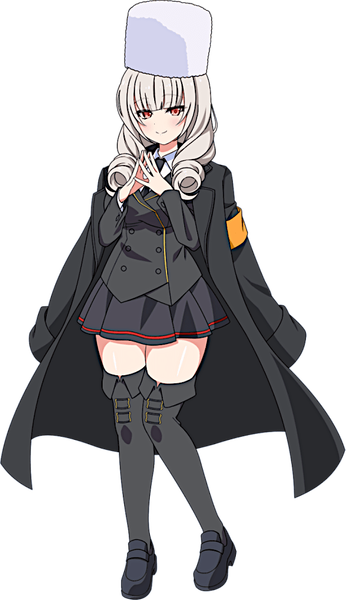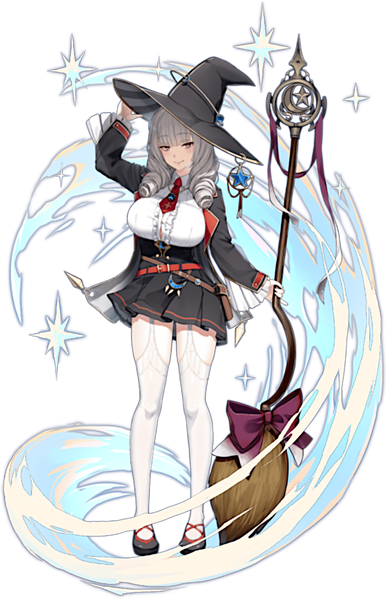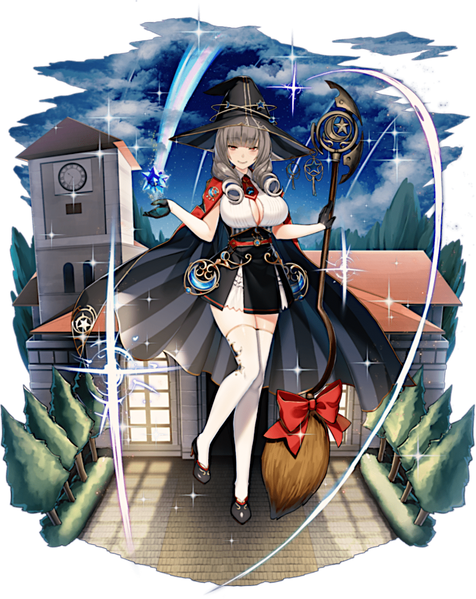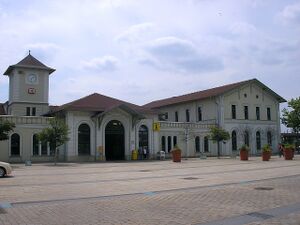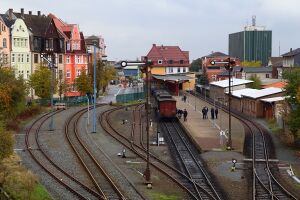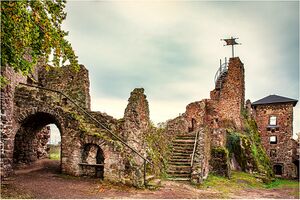Nordhausen
| Nordhausen | |||||
|---|---|---|---|---|---|
| Japanese Name | ノルトハウゼン | ||||
| Weapon | |||||
| Race | Human | ||||
| Nationality | |||||
| Birthday | July 10 | ||||
| Constellation | Cancer | ||||
| Talents | Setting off magical fireworks | ||||
| Likes | Grain spirits, Fireworks | ||||
| Dislikes | Central Army's arsenal, Weapons | ||||
| Strengths | Able to try again without being discouraged by failure | ||||
| Weaknesses | So absorbed with what she likes that she cannot see her surroundings | ||||
| Hobbies | Watching magic shows | ||||
My name is Nordhausen from the Harz Academy of Magic. I am a few years older than Wernigerode, but I graduated at the same time as her. I have a hard time remembering things and I failed many times. I may cause you trouble, but if there is anything I can do for you, please let me know.
Layers
| Icon | Title | Release Date | Where to Obtain |
|---|---|---|---|
| [Academy of Magic's Failure Student] Nordhausen | 2023 May 23 | [Altar of Judgement - Auberon the Fairy King] Event Reward | |
| [In Search of a Happy Meteor Shower] Nordhausen | 2023 June 15 | [Knights Template's Glorious Collapse] Pick Up Gacha, Premium Gacha | |
| [Wish Upon Fireworks] Nordhausen | 2023 May 23 | [White Horse Shooter and the Dropout Mage] Limited Gacha |
Skills
Trivia
- Nordhausen's birthday is the opening date of Nordhausen station in 1866 with the opening of the line to Halle.
- Similar to Wernigerode, Goslar and Quedlinburg, Nordhausen's magic theme is themed after the Walpurgisnacht and the Harz highlands. In the case of Nordhausen, the closest castle is the Hohnstein Castle, located near Neustadt in the vicinity of Nordhausen in Thuringia.
- Nordhausen's liking for grain spirits is a reference to the spirit production in real life Nordhausen. Notably, Nordhausen am Harz has maintained the unique tradition of grain distilling. Nordbrand Nordhausen is a spirits producer based in the town of the same name in the Harz Mountains.
- Nordhausen's fireworks theme is based on the Feuerwerk Nordhausen, a fireworks festival held in Nordhausen.
- The building in the background of [Wish Upon Fireworks] is the facade of Nordhausen Station.
Counterpart
Nordhausen station is a railway junction in the north of the German state of Thuringia and the main station in the city of Nordhausen. It is located just south of the city centre in the valley of the Zorge. The railway arrived in Nordhausen on 10 July 1866 with the opening of the line to Halle, which was extended on 9 July 1867 to the west to Eichenberg. In 1869, connections were added in the direction of Northeim (Südharzstrecke) and via Straußfurt to Erfurt. The narrow-gauge Harzquerbahn to Wernigerode, opened in 1897, completed the network that had been created; it starts at Nordhausen Nord station on the north side of the station.
In the 1991 Deutsche Reichsbahn timetable, the distance between the Nordhausen and Nordhausen Nord stations was given as 300 metres. The equally metre-gauge Nordhausen tramway provides a connection to most parts of the town; since 2004, there have been partially continuous courses. Between 1867 and 1869, a representative reception building with dining hall and waiting rooms was built, which was often extended or rebuilt over the years. In 1880, platform roofs and the first subway to the platforms were built. The station was electrified in 1994. It is also important for east-west freight traffic, which is why there is a large freight station to the east of the passenger station. In 1997/98, extensive reconstruction and conversion work began on the station building and later also on the station forecourt.
The Deutsche Bahn AG (IPA: [ˈdɔʏtʃə ˈbaːn]; abbreviated as DB or DB AG) is the national railway company of Germany, and a state-owned enterprise under the control of the German government. Headquartered in the Bahntower in Berlin, it is a joint-stock company (AG).
Deutsche Bahn describes itself as the second-largest transport company in the world, after the German postal and logistics company Deutsche Post / DHL, and is the largest railway operator and infrastructure owner in Europe. Deutsche Bahn was the largest railway company in the world by revenue in 2015; in 2019, DB Passenger transport companies carried around 4.8 billion passengers, and DB logistics companies transported approximately 232 million tons of goods in rail freight transport. Wikipedia
Hohnstein Castle (German: Burg Hohnstein) is one of the largest and best-preserved castle ruins in Germany and is located near Neustadt in the vicinity of Nordhausen in Thuringia. The ruins are located on a high, rocky spur which today is covered in woods, about 1 km northeast of the village of Neustadt on the southern edge of the Harz mountains. Honstein Castle was built in the time of the Hohenstaufen-Guelph conflict for the throne. Its foundation is attributed to Konrad von Sangerhausen, a relative of the legendary Thuringian count, Louis the Springer.
The Counts of Hohnstein, together with the Counts of Ilefeld who had married into them, inherited the lordship of the South Harz from Konrad. The newly founded dynasty of the Honstein-Ilfeld counts introduced the family Christian name, Elger, and chose Honstein Castle as their family seat; the modest Ilburg in nearby Ilfeld was probably abandoned at this point in time. The first mention of Honstein Castle was in 1202. Like the Thuringian landgraves, the Honstein clan rapidly amassed a considerable amount of territory, which included the regions around Arnstadt and Gotha in the Thuringian Basin. The first boom period for the family during the 13th century was followed by a loss of importance when, in 1315, the estate was divided between several family lines. Honstein Castle soon became militarily outdated. In 1380 it was captured for the first time and then again in 1412 during a family dispute, which degenerated into the so-called Flegler War, during the course of which the Hohnstein counts lost their family castle.
During the Peasants' War, Honstein was still seen as a secure fortification and was therefore selected by the abbott of Ilfeld Abbey to protect himself and the abbey treasure. Whilst the Counts of Hohnstein saw out the end of their reign at Lohra Castle (they died out in 1593), Hohnstein Castle was sold into the possession of the Counts of Stolberg, who modernised the fort militarily and structurally at great expense (including an artillery tower) and turned it into a typical Renaissance Schloss. During this period it became one of the largest castles in the Harz. During the Thirty Years War, however, Hohnstein Castle was destroyed by fire. Having been requisitioned in 1627 by an imperial officer, Colonel du Vuer, troops from the Electorate of Saxony under Lieutenant Colonel Vitztum von Eckstedt stormed the castle and drove out the imperial forces. Because Vitztum knew that he could not hold the castle for any length of time he placed the Counts of Stolberg under pressure so that he could extort money from them in return for handing it over. The Stollbergs could not (or would not) meet this ultimatum, so Vitztum had his soldiers set fire to the already heavily plundered castle on Christmas Eve of 1627.
According to tradition, Vitztum knew how to foil every attempt by guards on duty to put the fires out. Only a few usable remnants could be recovered from the blackened ruins following the withdrawal of Vitztum's troops; these included the clock from the castle chapel and the altar of the palace chapel. In the course of the following decades and centuries the castle ruins continued to decay. In 1908 an inn was built below the ruins. After 1990 safety and restoration work on the castle ruins was started. In Easter 2001 the castle was once again re-occupied. Wikipedia
Map
Gallery
- Pages using Tabber parser tag
- Pages using DynamicPageList3 parser tag
- Weapon Staff
- Human
- Eisengrad
- Cancer
- Element Blow
- Element Fire
- Train Knights
- Germany

